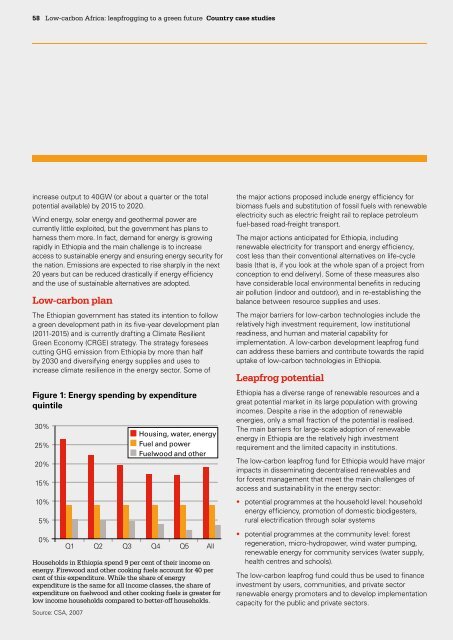Ju8uG
Ju8uG
Ju8uG
Create successful ePaper yourself
Turn your PDF publications into a flip-book with our unique Google optimized e-Paper software.
58 Low-carbon Africa: leapfrogging to a green future Country case studies<br />
increase output to 40GW (or about a quarter or the total<br />
potential available) by 2015 to 2020.<br />
Wind energy, solar energy and geothermal power are<br />
currently little exploited, but the government has plans to<br />
harness them more. In fact, demand for energy is growing<br />
rapidly in Ethiopia and the main challenge is to increase<br />
access to sustainable energy and ensuring energy security for<br />
the nation. Emissions are expected to rise sharply in the next<br />
20 years but can be reduced drastically if energy efficiency<br />
and the use of sustainable alternatives are adopted.<br />
Low-carbon plan<br />
The Ethiopian government has stated its intention to follow<br />
a green development path in its five-year development plan<br />
(2011-2015) and is currently drafting a Climate Resilient<br />
Green Economy (CRGE) strategy. The strategy foresees<br />
cutting GHG emission from Ethiopia by more than half<br />
by 2030 and diversifying energy supplies and uses to<br />
increase climate resilience in the energy sector. Some of<br />
Figure 1: Energy spending by expenditure<br />
quintile<br />
30%<br />
25%<br />
20%<br />
15%<br />
10%<br />
5%<br />
0%<br />
Households in Ethiopia spend 9 per cent of their income on<br />
energy. Firewood and other cooking fuels account for 40 per<br />
cent of this expenditure. While the share of energy<br />
expenditure is the same for all income classes, the share of<br />
expenditure on fuelwood and other cooking fuels is greater for<br />
low income households compared to better-off households.<br />
Source: CSA, 2007<br />
Housing, water, energy<br />
Fuel and power<br />
Fuelwood and other<br />
Q1 Q2 Q3 Q4 Q5 All<br />
the major actions proposed include energy efficiency for<br />
biomass fuels and substitution of fossil fuels with renewable<br />
electricity such as electric freight rail to replace petroleum<br />
fuel-based road-freight transport.<br />
The major actions anticipated for Ethiopia, including<br />
renewable electricity for transport and energy efficiency,<br />
cost less than their conventional alternatives on life-cycle<br />
basis (that is, if you look at the whole span of a project from<br />
conception to end delivery). Some of these measures also<br />
have considerable local environmental benefits in reducing<br />
air pollution (indoor and outdoor), and in re-establishing the<br />
balance between resource supplies and uses.<br />
The major barriers for low-carbon technologies include the<br />
relatively high investment requirement, low institutional<br />
readiness, and human and material capability for<br />
implementation. A low-carbon development leapfrog fund<br />
can address these barriers and contribute towards the rapid<br />
uptake of low-carbon technologies in Ethiopia.<br />
Leapfrog potential<br />
Ethiopia has a diverse range of renewable resources and a<br />
great potential market in its large population with growing<br />
incomes. Despite a rise in the adoption of renewable<br />
energies, only a small fraction of the potential is realised.<br />
The main barriers for large-scale adoption of renewable<br />
energy in Ethiopia are the relatively high investment<br />
requirement and the limited capacity in institutions.<br />
The low-carbon leapfrog fund for Ethiopia would have major<br />
impacts in disseminating decentralised renewables and<br />
for forest management that meet the main challenges of<br />
access and sustainability in the energy sector:<br />
• potential programmes at the household level: household<br />
energy efficiency, promotion of domestic biodigesters,<br />
rural electrification through solar systems<br />
• potential programmes at the community level: forest<br />
regeneration, micro-hydropower, wind water pumping,<br />
renewable energy for community services (water supply,<br />
health centres and schools).<br />
The low-carbon leapfrog fund could thus be used to finance<br />
investment by users, communities, and private sector<br />
renewable energy promoters and to develop implementation<br />
capacity for the public and private sectors.


